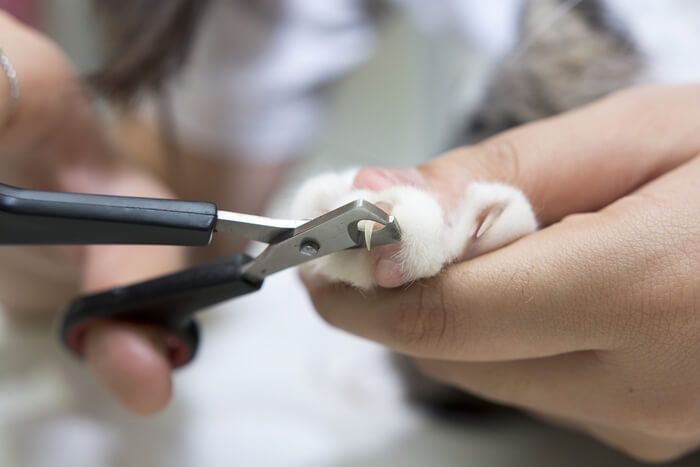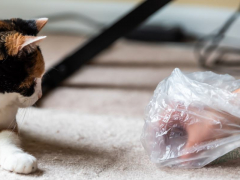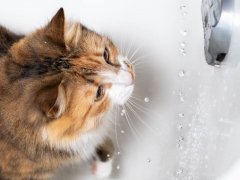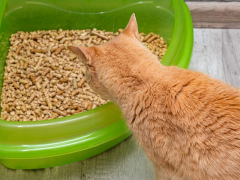
Every cat, wild or domestic, will scratch from a young age. Scratching is an ingrained instinct, meaning cats don’t need to learn how to scratch. Scratching is usually done with the front paws in a vertical fashion on hard surfaces, or less commonly, in a horizontal manner by pulling themselves along the floor with their front claws.
There are many reasons cats scratch and it’s important to know that this is a completely normal cat behavior. Sometimes scratching can be a little annoying for us when their attention turns away from toys or scratching posts and instead focuses on our furniture or curtains. Repeated scratching can cause huge damage within a short space of time, so understanding why cats scratch can help us avoid destructive scratching around the home.
So, why do cats scratch? There are four main reasons cats scratch:
1. Territory Marking
The first reason cats scratch is to mark territory, or define an area that is safe for them to be in. It creates comfort and peace, allowing them to truly relax knowing that their safe space is clearly defined to strangers.
Other cats will see the visual markings and smell the scratch marks, and avoid entering this space. Cats mark outside the home on strong, hard surfaces like trees and fences. These strong surfaces hold the scratch marks and the associated scent well, allowing the signals to last longer.
2. Scent Marking
When a cat’s claws engage in scratching behavior, the scent glands hidden in their paws release a scent that mixes with the sweat from the sweat glands. This releases an odor truly unique to that cat onto the surface they are marking.
Any cat in the area who sniffs this marked surface will be able to tell that it has been marked by another cat and be able to establish their area based on the locations marked. The scent doesn’t last permanently, so cats regularly need to go back to scratch marks and top up the scent to keep their area free from unwanted visitors.
3. Nail Health

Trim your cat’s nails every two to four weeks to help them stay healthy.
A cat’s nails will continually grow throughout their lives. This means that small pieces of the dead nail will from time to time fray or break away from the main body of the nail. Scratching on hard surfaces like sandpaper can help to remove the loose nails and keep your cat comfortable.
Using scratching posts also helps to keep the nails nice and sharp, which is beneficial for outdoor cats for climbing and running. Sharp claws help cats to defend themselves against attackers.
4. Muscle Movement
Scratching involves stretching and relaxing muscles which is important for muscle health. Cats commonly use the scratching post after waking up from a nap and this helps to wake up all the muscles they will use for the rest of the day in normal activity.
Cat owners can use this to their advantage, and place scratching posts near the area your cat prefers to sleep or nap. This gives an easy scratching option when your cat wakes up, so they don’t have to go looking for alternatives.
What Makes a Good Scratching Post?
In nature, wood makes the perfect scratching post due to its texture and solid structure. In the home, we don’t want to encourage scratching on wooden surfaces so when buying a new scratching post or scratching pad there are certain things to look out for that will encourage your cat to use it.
The cat scratching post needs to be solid and strong, so as not to fall over if clawed. A cat will not use a scratch post that falls over if it risks causing injury. The scratch post needs to be tall as cats enjoy vertical scratching, and large enough to fit both paws on the pole or pad at one time. Look for materials like sisal rope as this is durable and will withstand repeated scratching.
Some scratching posts or cat trees come with additional cat toys or are laced with catnip. These are good features to look out for as they are engaging for your cat and will entice them to play and use the scratching post.
Tips To Stop Scratching Around the Home

With consistency, it’s possible to keep your cat using scratching posts rather than your furniture.
This is a slow process and will not improve instantly overnight, but you will see progress if you are consistent with the following tips:
- Clean any hard surfaces like wood that have been scratched to remove any remaining scent. By removing the scent, you reduce the urge to remark this area. Sand out the scratch marks to reduce the visual impact as well.
- Provide lots of scratching options for your cats, you need at least one scratch area per cat in your home.
- Protect furnishings from further damage by using deterrents such as double-sided sticky tape, or for large areas, consider furniture protectors like those from Katsupreme. These furniture protectors do not allow the cat’s claws to sink into the material; cats quickly lose interest in the protected area as they are no longer able to mark it.
- Not all cats prefer a vertical scratching surface. If your cat refuses to use a scratch pole, try a horizontal scratching area instead with material such as sandpaper or cardboard. Secure the scratch pad well to the floor or buy one that is heavy enough to not move during use. These types of cat scratchers can be easily made yourself with items around the home, so are an affordable option.
- If possible allow your cat access outdoors, even if just catio access. This allows extra space for them to exhibit their natural behaviors, so they feel less inclined to perform them in the home instead.
Stress and Anxiety
If your cat usually has no issues using a scratching post and then suddenly starts scratching around the home, particularly on surfaces like carpets, they may be trying to communicate they feel troubled or anxious.
Getting a health check with a veterinarian is always a good idea to rule out medical causes of anxiety or stress. If your cat is physically healthy, you may need to look at changes around the home, such as a microchip cat flap to prevent strangers from wandering in, or the use of pheromone sprays such as Feliway to help your cat relax. Having a safe space your cat can retreat to with ample food, water, and a litter box will also help your cat to feel less anxious.
Summary
Any cat behaviorist will confirm that cat scratching is a natural behavior, one that doesn’t need to be taught. Scratching is a form of communication and allows cats to feel safe in their home environment. It’s important for cats to have plenty of access to safe scratching materials and posts around the home to express this normal behavior.
If your cat is scratching around the home, try to be patient and remember this is normal behavior that we must redirect onto more suitable objects over time. The earlier you start this training, the more successful it will be, so having the right gear from the first day your new cat enters your home can really set you up for success.
Also Read: How to Choose the Right Scratching Post







